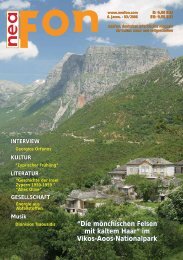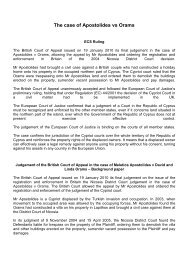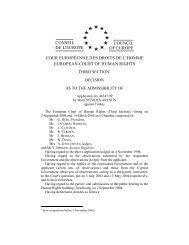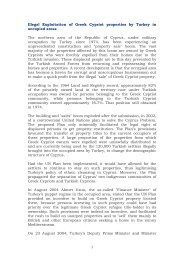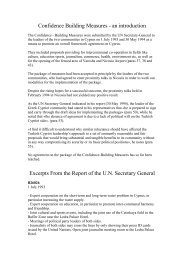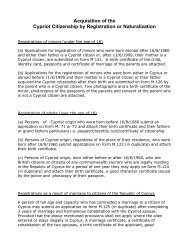Volume L, No 3, July-September 2012 - Ministry of Foreign Affairs
Volume L, No 3, July-September 2012 - Ministry of Foreign Affairs
Volume L, No 3, July-September 2012 - Ministry of Foreign Affairs
You also want an ePaper? Increase the reach of your titles
YUMPU automatically turns print PDFs into web optimized ePapers that Google loves.
working dough for bread, ploughing, etc.), is repeated<br />
after thousands <strong>of</strong> years in the expressive<br />
density <strong>of</strong> naive ceramic compositions by Demetrakis<br />
Gerokostas or the painterly figures by Stass<br />
Paraskos, recorded in static flatness and reduced to<br />
hieratic, featureless entities. In the work <strong>of</strong> Nikos<br />
Charalambides, a Tanagra type <strong>of</strong> figurine from<br />
Amathus (310-30 B.C.), probably an Aphrodite,<br />
is depicted next to Marcel Duchamp, in an oeuvre<br />
that sweeps away the dividing lines between space<br />
and time, blurring Hellenistic art with the 20 th century<br />
avant-garde artistic genres. The tethrippon<br />
(chariot drawn by four horses) <strong>of</strong> the Cypro-Archaic<br />
I-II (650-480 B.C.) from the Sanctuary <strong>of</strong> Apollo<br />
Hylates at Kourion becomes an organic part <strong>of</strong> the<br />
sculptural installation by Maria Loizidou, whose<br />
four horses in mixed media represent a visual metonymy<br />
<strong>of</strong> the stifled speech (ά-λογον) in estranging<br />
modern metropolitan societies.<br />
The 13 th century icon <strong>of</strong> Saint Mamas, from Amiantos,<br />
is juxtaposed with the emblematic reduction<br />
<strong>of</strong> the ‘White Saint’ by Angelos Makrides, which<br />
schematically outlines a half-length, frontal depiction<br />
<strong>of</strong> any saint’s figure, while the relief ornamentation<br />
<strong>of</strong> this icon, with repetitive geometrical patterns,<br />
is reproduced in the drawing <strong>of</strong> Antonis Neophytou,<br />
executed in gesso and plastic and engraved<br />
on silver-plated copper, in a process evocative <strong>of</strong><br />
the Byzantine technique and the ceremonial rituals<br />
associated with Orthodox icon decoration.<br />
According to Dr Maria Hadjicosti, Director <strong>of</strong><br />
the Department <strong>of</strong> Antiquities, which gave permission<br />
for the display <strong>of</strong> all the antiquities as<br />
requested by the curator <strong>of</strong> the exhibition, “It is<br />
very interesting that the same ideas and the same<br />
artistic expressions in the objects <strong>of</strong> our ancient<br />
history reappear today. The exhibition proves that<br />
cultural life in Cyprus has continued throughout<br />
history.” Ms Catherine Nikita, Director <strong>of</strong> the<br />
Evagoras Lanitis Centre, remarked that “due to<br />
the materialisation <strong>of</strong> Dr Nadia Anaxagorou’s<br />
concept, it is the first time that we have shown<br />
such a large number <strong>of</strong> objects from antiquity and<br />
the Byzantine period together with modern objects,<br />
covering different phases <strong>of</strong> Cypriot artistic<br />
creation.” Last but not least, the Mayor <strong>of</strong> Lemesos,<br />
Mr Andreas Christou, stressed that “this exhibition<br />
marks a culmination in the pioneering<br />
contribution <strong>of</strong> the Municipality <strong>of</strong> Lemesos in<br />
the field <strong>of</strong> visual arts.”<br />
An unguentarium <strong>of</strong> plain white ware <strong>of</strong> the Roman period (2 nd -3 rd c. A.D.), from Kourion, Ayios Ermogenis, 12.5 cm., placed in the cube<br />
<strong>of</strong> Theodoulos Gregoriou, Cells IV, cement, minerals, copper, oxide and transparent mirror, 75x75x84 cm.<br />
21



